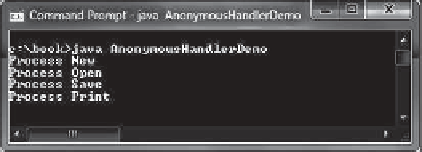Java Reference
In-Depth Information
public void
start(Stage primaryStage) {
// Omitted
public void
start(Stage primaryStage) {
// Omitted
btEnlarge.setOnAction(
new
EnlargeHandler());
btEnla
rge.setOnAction(
ne
w class
En
largeHandlner
implements
EventHandler<ActionEvent>() {
public void
handle(ActionEvent e) {
circlePane.enlarge();
}
});
}
}
class
EnlargeHandler
implements
EventHandler<ActionEvent> {
public void
handle(ActionEvent e) {
circlePane.enlarge();
}
}
(a) Inner class
EnlargeListener
(b) Anonymous inner class
The syntax for an anonymous inner class is shown below
new
SuperClassName/InterfaceName() {
// Implement or override methods in superclass or interface
// Other methods if necessary
}
Since an anonymous inner class is a special kind of inner class, it is treated like an inner class
with the following features:
An anonymous inner class must always extend a superclass or implement an inter-
face, but it cannot have an explicit
extends
or
implements
clause.
■
An anonymous inner class must implement all the abstract methods in the superclass
or in the interface.
■
An anonymous inner class always uses the no-arg constructor from its superclass to
create an instance. If an anonymous inner class implements an interface, the con-
structor is
Object()
.
■
An anonymous inner class is compiled into a class named
OuterClassName$
n
.
class
. For example, if the outer class
Test
has two anonymous inner classes, they
are compiled into
Test$1.class
and
Test$2.class
.
■
Listing 15.4 gives an example that handles the events from four buttons, as shown in
Figure 15.8.
F
IGURE
15.8
The program handles the events from four buttons.
L
ISTING
15.4
AnonymousHandlerDemo.java
1
import
javafx.application.Application;
2
import
javafx.event.ActionEvent;
3
import
javafx.event.EventHandler;
4
import
javafx.geometry.Pos;
5
import
javafx.scene.Scene;
VideoNote
Anonymous handler
























Search WWH ::

Custom Search